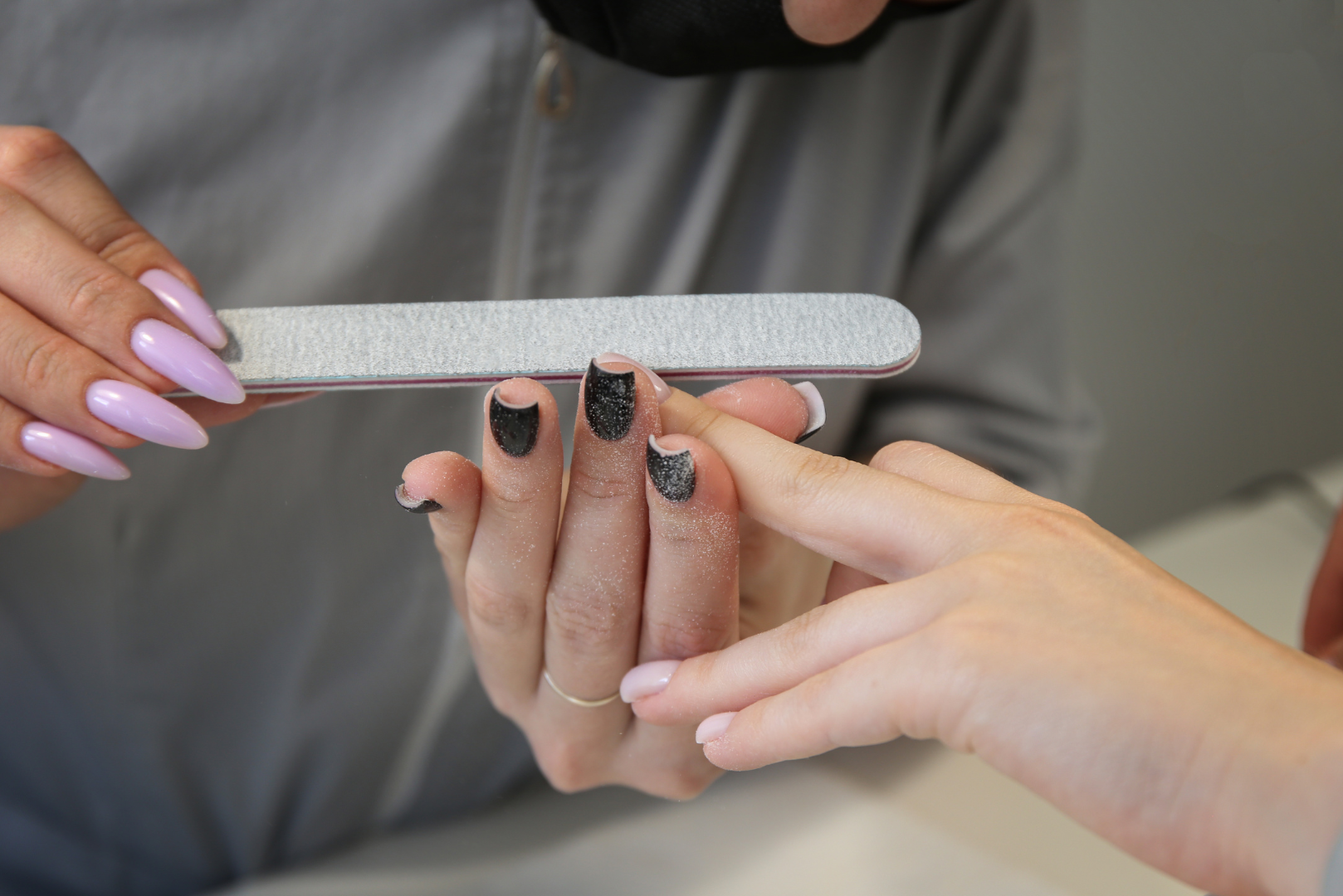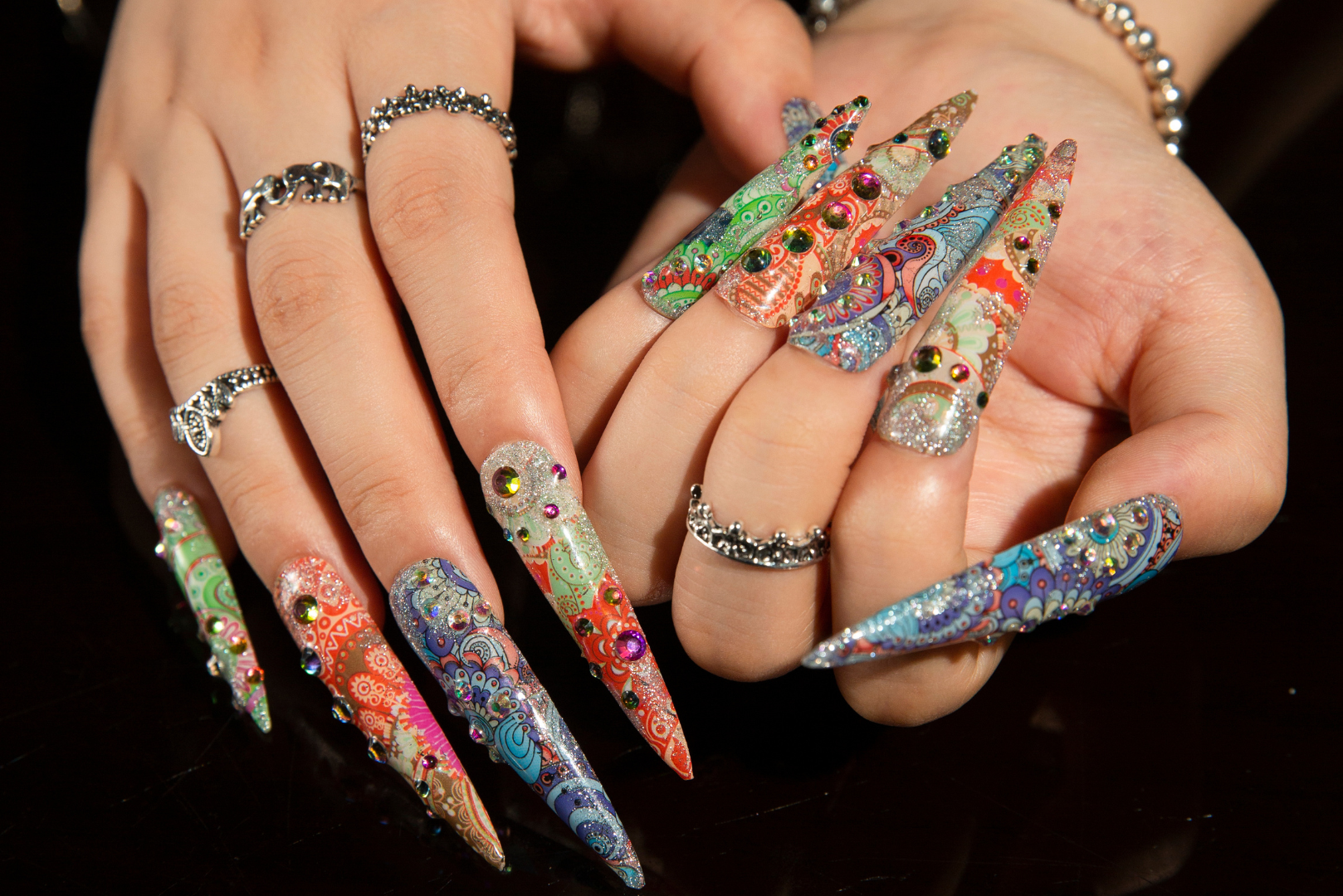
Typing with long, beautiful nails can be tricky, but it’s a skill you can master with the right techniques and practice. This guide will show you how to choose the best nail shape for typing, change the way you type to protect your nails, set up your work area for comfort, and train your fingers to type smoothly. You’ll be able to rock your stunning nails while typing like a pro in no time!

Choosing the Right Nail Shape for Typing
When typing with long nails, selecting the right nail shape is the first step to success. The shape of your nails can greatly impact your typing experience, making it either a breeze or a challenge. To ensure comfort and ease, it’s also important to choose the right size press-on nails that suit your nail bed perfectly.
Round Nails: Best for Beginners
If you’re just starting to type with long nails, round or oval shapes are the most forgiving option. The curved edges create a smooth surface for your fingertips to glide over the keys without snagging. Round nails are practical and less likely to catch on the keyboard, minimizing the risk of cracks or breaks.
Stiletto Nails: Manageable with the Right Length
Don’t discount stiletto nails just yet! While their narrow, pointed tips may seem like a typing nightmare, many long-nail veterans have mastered this dramatic style. The key is to ensure the points are not too long or sharp, which can make it difficult to control your typing accurately.
Square and Coffin Nails: Most Challenging for Typing
Square and coffin-shaped nails with their straight, flat edges can present the biggest challenge for typists. The blunt surfaces can catch on the keys, increasing the likelihood of breaks or surface chips. If you prefer these shapes, you may need to keep your nails slightly shorter or opt for a softly rounded edge.
Typing Techniques Adapted for Long Nails
To type comfortably and efficiently with long nails, you’ll need to make a few adjustments to your technique.
Using Your Fingertips: A Gentler Approach
When you have long nails, one of the biggest changes you’ll need to make is using your fingertips to press the keys instead of your nail tips. This means you’ll be typing with the soft, fleshy part of your finger just below the nail. It might feel a bit strange at first, but it’s much better for your nails. Typing this way puts less stress on your nails and gives you better control over which keys you’re hitting. Stick with it, and soon it will feel totally natural.
Tapping the Keys: A Lighter Touch
Another way to protect your nails while typing is to change the way you press the keys. Rather than pushing down hard and letting your fingers sink deep into the keys, try to tap the keys with a quick light motion. Imagine you’re gently tapping the keys with your fingertips rather than really pressing them. This “tapping” technique reduces the chances of your nails coming into contact with the keys and getting snagged or broken. It might take a bit of practice to get used to this lighter touch, but your nails will thank you!

Hand Positioning and Movement
In addition to adjusting your typing technique, it’s crucial to pay attention to your hand positioning and movement to minimize the risk of damaging your nails and to type more efficiently.
Minimalistic Movement: Keeping Hands Stationary
Unlike traditional typing where hands float across the keyboard, long nails require a more minimalistic approach to hand movement. Try to keep your hands relatively stationary, using your fingers to reach the keys rather than shifting your entire hand position constantly. This technique minimizes the potential for your nails to catch on the keyboard.
The Pianist Approach: Fluid Finger Movements
Take a cue from pianists and employ similar fluid, independent finger movements when typing with long nails. Avoid the tendency to move your whole hand or lock your fingers together. Instead, keep your hands relaxed and let your fingers move fluidly across the keys, much like playing an instrument.
Posture and Ergonomics
Proper posture and ergonomics go hand in hand with the right typing techniques and hand positioning to ensure comfortable, efficient typing with long nails.
Proper Seating Posture: Alignment and Hand Placement
Maintaining proper posture is crucial for comfortable, strain-free typing – especially with long nails. Sit with your back straight and shoulders relaxed, positioning the keyboard at a height that allows your forearms to rest parallel to the floor. This alignment prevents excessive wrist bending or awkward hand positions that could lead to nail damage.
Keyboard Selection: Ergonomic Options
Consider investing in an ergonomic keyboard designed to keep your wrists in a neutral position. Split or curved layouts can significantly reduce strain and improve your ability to type with long nails while maintaining good form. Wireless models also allow for more flexibility in positioning the keyboard at the ideal angle.

Finger Placement and Keyboard Familiarity
Developing proper finger placement and building muscle memory are crucial for typing efficiently with long nails.
Learning Correct Finger Placement
Even if you’re an experienced touch-typist, having long nails may require relearning proper finger placement on the keyboard. Take the time to reacquaint yourself with the QWERTY layout, consciously placing each finger on its designated key or key cluster. This mindful approach will help build muscle memory specific to typing with long nails.
Building Muscle Memory: Adaptation Exercises
To solidify your new typing patterns, engage in regular exercises that reinforce correct finger placement and controlled movements. Start with simple drills like typing out the home row keys or practicing common word patterns. Gradually increase the complexity as your muscle memory develops, ensuring your long nails don’t hinder your speed or accuracy.
Emphasizing Accuracy Over Speed
As you build your typing skills with long nails, it’s essential to focus on accuracy first and gradually work on increasing your speed.
Initial Focus on Precision
When learning to type with long nails, prioritize accuracy over raw speed. Typing hastily with long nails is a recipe for frustration and potential nail damage. Instead, concentrate on striking each key cleanly and with control. As you build confidence and muscle memory, your speed will naturally improve.
Speed Development: Incremental Increases
Once you’ve mastered precise typing with your long nails, you can work on increasing your words-per-minute rate. Use online typing tests or practice exercises that provide your current speed metric. Aim for small, incremental increases over time rather than pushing yourself too hard too soon.
Auxiliary Tools and Accessories
Apart from adopting the right techniques and maintaining proper posture, using auxiliary tools and accessories can make typing with long nails more comfortable and efficient.
Keyboard Covers: Noise and Nail Protection
Invest in a keyboard cover or skin designed to reduce noise and protect your nails from excessive wear-and-tear. These covers create a smooth surface that allows your fingers to glide effortlessly without snagging. Many also feature a soft rubber texture that absorbs the impact of your strokes.
Trackball Mouse: Accommodating Long Nails
While you’ve mastered typing, having long nails can make using a traditional mouse difficult. A trackball mouse puts all the control under your thumbs or fingers without any grasping or clicking required. This accessory is an easy way to extend your long nail prowess to mouse operations.
Stylus Use for Touchscreens: When Needed
There will be times when even your sharpest nail-typing skills won’t cut it – like when using a smartphone or tablet’s touchscreen. Keep a stylus on hand for those occasions when precise taps are required. Rubber-tipped or mesh styli work well without damaging your manicure.
Health and Safety Considerations
Typing with long nails can be more physically demanding than you might expect. Be sure to take frequent, short breaks to prevent strain, fatigue, or the temptation to type more forcefully (which risks breaking a nail). Stand up, stretch, and give your hands a rest every 20-30 minutes.
Incorporate simple stretches and exercises into your routine to improve flexibility and reduce the risk of repetitive stress injuries. Gently extend and flex your wrists and fingers, or try stress ball squeezes to keep your hands and forearms feeling good during long typing sessions.
Rocking Fabulous Nails While Typing Like a Pro
You don’t have to sacrifice your stunning manicure to be a typing pro. With a little patience, practice, and the right techniques, you can absolutely rock those gorgeous long nails while typing like a boss. It might take some time to get used to the adjustments, like using your fingertips instead of your nail tips and keeping your hands still, but stick with it! Before you know it, you’ll be typing away with ease, speed, and accuracy. And don’t forget to take good care of yourself along the way – regular breaks, stretches, and the right tools can make all the difference. So go ahead and flaunt those fabulous nails at the keyboard, knowing that you’ve got the skills to make it work!


